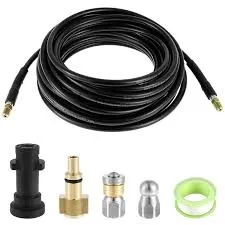Steps to Replace Your Power Steering Hose Effectively and Efficiently
Replacing Power Steering Hose A Step-by-Step Guide
Power steering is essential for modern vehicles, providing a smoother and more manageable driving experience. However, like any other component in your vehicle, power steering hoses are susceptible to wear and tear over time. If you notice signs such as a steering wheel that feels stiff, whining noises when turning, or fluid leaks under the vehicle, it might be time to replace your power steering hose. In this article, we'll take a detailed look at how to replace the power steering hose effectively.
Understanding the Power Steering System
The power steering system helps drivers steer the vehicle by using hydraulic pressure to assist in turning the steering wheel. The power steering hose transports fluid from the pump to the steering gear or rack. There are typically two hoses the high-pressure hose and the return hose. While both can wear out, the high-pressure hose is more prone to damage due to the intense pressure it endures.
Tools and Materials Needed
Before starting the replacement process, gather the necessary tools and materials
- New power steering hose (high-pressure or return hose, depending on what you’re replacing) - Wrench set - Socket set - Screwdriver - Fluid catch pan - Power steering fluid - Safety goggles - Gloves
Step-by-Step Replacement Process
1. Safety First Begin by ensuring your vehicle is parked on a flat surface with the engine turned off and cool. Put on safety goggles and gloves to protect yourself from any fluid spills.
2. Locate the Power Steering Hoses Open the hood and locate the power steering pump. Trace the hoses from the pump to the steering gear. Identify which hose needs replacement.
replacing power steering hose

3. Prepare to Drain Fluid Place a fluid catch pan under the power steering system to catch any leaking fluid during the removal process.
4. Disconnect the Battery For safety reasons, disconnect the negative terminal of the battery to prevent any electrical issues during the replacement.
5. Remove the Old Hose Using the appropriate wrench or socket, carefully loosen and disconnect the fittings on both ends of the hose. Be prepared for some fluid to spill, which is why the catch pan is crucial. If the hose is stuck due to corrosion, a little bit of penetrating oil can help loosen it.
6. Install the New Hose Once the old hose is removed, take your new power steering hose and install it by connecting the fittings to the power steering pump and steering gear. Make sure to tighten the connections securely, but avoid overtightening, as this can cause damage to the fittings.
7. Refill Power Steering Fluid After the new hose is in place, refill the power steering fluid reservoir with the appropriate type of power steering fluid recommended for your vehicle. Check your owner's manual for guidance.
8. Bleed the Power Steering System Start the engine and allow it to run for a few minutes. Turn the steering wheel from lock to lock several times to help purge any air from the system. This step is crucial as it ensures the system is operating efficiently and reduces the chances of air bubbles causing steering issues.
9. Check for Leaks After bleeding the system, turn off the engine and inspect the hose connections for any signs of leaks. If everything looks good, replace the cap on the fluid reservoir.
10. Reconnect the Battery Finally, reconnect the negative terminal of the battery.
Conclusion
Replacing a power steering hose might seem daunting, but with the right tools and a bit of patience, it is a manageable task for many DIY enthusiasts. Regular maintenance of your power steering system helps ensure a safer and more pleasant driving experience. If you encounter any difficulties during the process or are uncertain at any stage, don't hesitate to consult a professional mechanic. Safe driving!
-
Ultimate Spiral Protection for Hoses & CablesNewsJun.26,2025
-
The Ultimate Quick-Connect Solutions for Every NeedNewsJun.26,2025
-
SAE J1401 Brake Hose: Reliable Choice for Safe BrakingNewsJun.26,2025
-
Reliable J2064 A/C Hoses for Real-World Cooling NeedsNewsJun.26,2025
-
Heavy-Duty Sewer Jetting Hoses Built to LastNewsJun.26,2025
-
Fix Power Steering Tube Leaks Fast – Durable & Affordable SolutionNewsJun.26,2025

